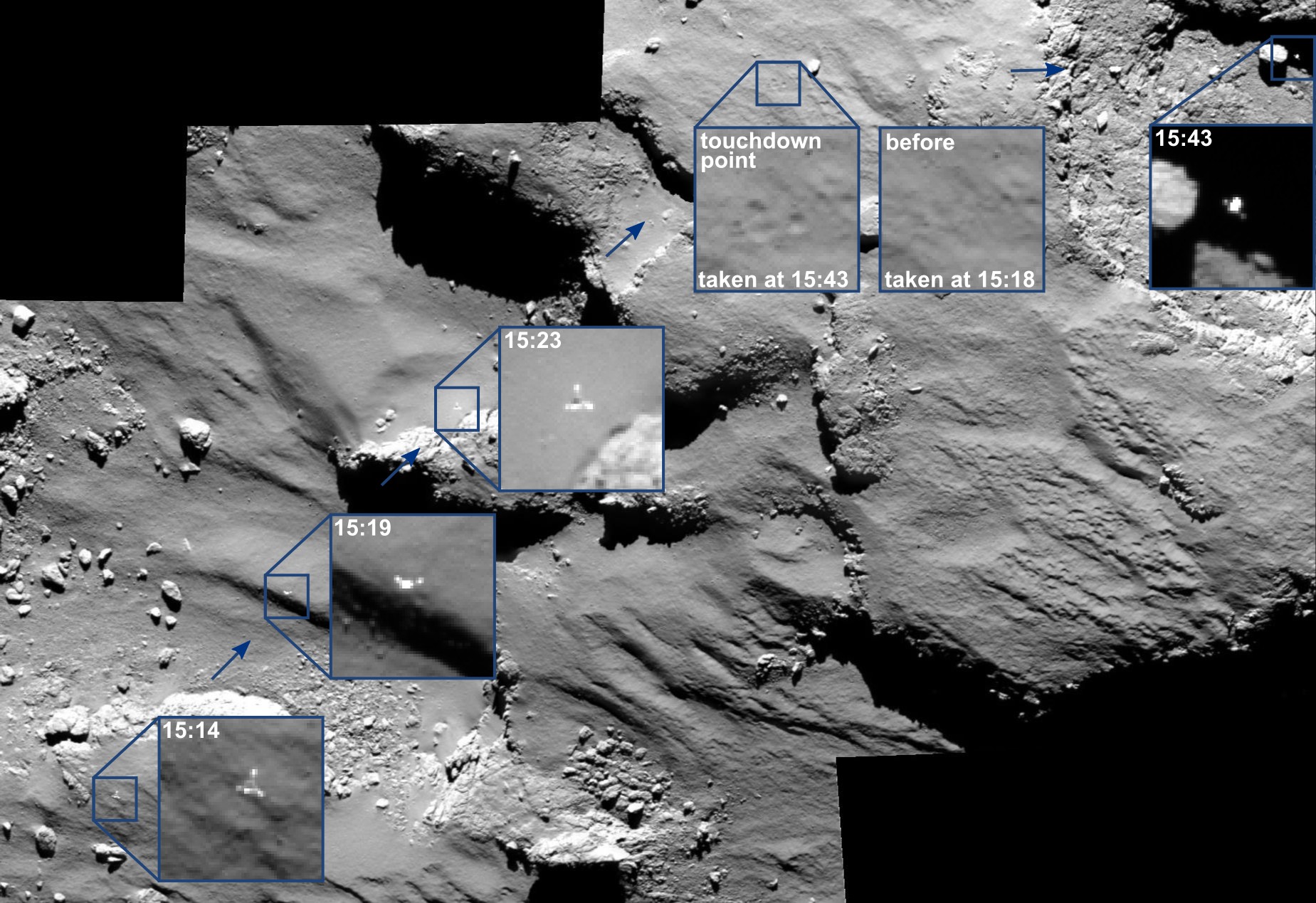Philae Comet Lander's Big Bounce Captured in Amazing Photos

The Philae lander's big bounce off a comet last week was captured by its orbiting mothership in a series of stunning photos.
Philae separated from the European Space Agency's (ESA) Rosetta spacecraft last Wednesday (Nov. 12) and spiraled down to the surface of Comet 67P/Churyumov–Gerasimenko to make history's first-ever soft landing on a comet. But the lander's anchoring harpoons didn’t fire as planned, and Philae bounced off 67P's surface twice Wednesday before finally coming down for good.
Newly released photos by Rosetta show Philae's descent toward the comet and the 220-lb. (100 kilograms) probe's position shortly after its first bounce, which lasted 1 hour and 50 minutes. The images span 30 minutes around Philae's initial touchdown, which occurred at about 10:35 a.m. EST (1535 GMT) Wednesday. [See comet photos from Rosetta and Philae]
"From left to right, the images show Philae descending towards and across the comet before touchdown," ESA officials wrote in an image description today (Nov. 17). "The image taken after touchdown, at 1543 GMT, confirms that the lander was moving east, as first suggested by the data returned by the CONSERT experiment, and at a speed of about 0.5 m/s [1.1 mph]."
CONSERT is Philae's Comet Nucleus Sounding Experiment by Radiowave Transmission instrument, which is designed to probe the structure of 67P's core using radio waves.
Philae's second bounce was much less extreme, lasting just 7 minutes. Mission officials still aren't sure where the probe ended up, but they're confident images and data collected by both Philae and the Rosetta mothership will allow them to find the lander eventually.
While Philae's touchdown didn't go entirely as planned, ESA officials are still declaring the probe's mission a success. Philae managed to complete its "first science sequence," gathering a great deal of data about 67P using 10 different instruments, they said.
Breaking space news, the latest updates on rocket launches, skywatching events and more!
Philae operated for about 57 hours on the comet's surface before its primary batteries ran out. The original plan calls for the lander to continue working over the next few months or so using batteries that are recharged by onboard solar panels. Philae's heavily shaded final resting place on 67P will make that difficult, mission officials have said, though they've expressed hope that communication with the lander could be re-established in the future, when 67P gets closer to the sun.
The Rosetta mission launched in 2004 and chased down 67P a decade later, arriving in orbit around the comet this past August. The mission's main goal is to better understand comet composition and behavior, which could shed light on the conditions prevalent when the solar system was forming 4.6 billion years ago.
Rosetta will continue studying the comet from orbit until at least December 2015.
Follow Mike Wall on Twitter @michaeldwall and Google+. Follow us @Spacedotcom, Facebook or Google+. Originally published on Space.com.

Michael Wall is a Senior Space Writer with Space.com and joined the team in 2010. He primarily covers exoplanets, spaceflight and military space, but has been known to dabble in the space art beat. His book about the search for alien life, "Out There," was published on Nov. 13, 2018. Before becoming a science writer, Michael worked as a herpetologist and wildlife biologist. He has a Ph.D. in evolutionary biology from the University of Sydney, Australia, a bachelor's degree from the University of Arizona, and a graduate certificate in science writing from the University of California, Santa Cruz. To find out what his latest project is, you can follow Michael on Twitter.

